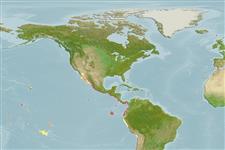>
Carangaria/misc (Various families in series Carangaria) >
Centropomidae (Snooks)
Etymology: Centropomus: Greek, kentron = sting + Greek, poma, -atos = cover, operculum (Ref. 45335).
More on author: Günther.
Environment: milieu / climate zone / depth range / distribution range
Ecología
marino; agua dulce; salobre demersal. Tropical; 29°N - 6°S, 113°W - 76°W (Ref. 129711)
Eastern Pacific: southern Baja California, Mexico and mouth of the Gulf of California to Colombia and Peru.
Tamaño / Peso / Age
Maturity: Lm ? range ? - ? cm
Max length : 123 cm TL macho / no sexado; (Ref. 40637); common length : 45.0 cm TL macho / no sexado; (Ref. 55763); peso máximo publicado: 26.2 kg (Ref. 40637)
Body slender and not very deep; dorsal profile slightly concave behind the eyes; lateral line extending to posterior edge of caudal fin; second anal spine, when folded down, well removed from origin of caudal fin; pectoral and pelvic fins sub-equal; anal fin with 6 rays; back blue gray; belly white; lateral line very dark; fins charcoal gray (Ref. 55763).
Adults enter mangrove areas and lagoons. Also occur in estuaries (Ref. 11035) and fresh water (Ref. 4537), as well as rustic ponds (Ref. 85798).
Life cycle and mating behavior
Madurez | Reproducción | Puesta | Huevos | Fecundidad | Larva
Bussing, W.A., 1995. Centropomidae. Róbalos. p. 987-995. In W. Fischer, F. Krupp, W. Schneider, C. Sommer, K.E. Carpenter and V. Niem (eds.) Guia FAO para Identification de Especies para lo Fines de la Pesca. Pacifico Centro-Oriental. 3 Vols. FAO, Rome. (Ref. 9284)
IUCN Red List Status (Ref. 130435)
Threat to humans
Harmless
Human uses
Pesquerías: comercial; pesca deportiva: si
Más información
Nombres comunesSinónimosMetabolismoDespredadoresEcotoxicologíaReproducciónMadurezPuestaAgregación para la puestaFecundidadHuevosEgg development
ReferenciasAcuiculturaPerfil de acuiculturaRazasGenéticaElectrophoresesheritabilidadEnfermedadesProcesamientoNutrientsMass conversion
ColaboradoresImágenesStamps, Coins Misc.SonidosCiguateraVelocidadTipo de nataciónSuperficie branquialOtolitosCerebrosVisión
Herramientas
Special reports
Download XML
Fuentes de Internet
Estimates based on models
Preferred temperature (Ref.
123201): 22.8 - 29.1, mean 26.9 °C (based on 207 cells).
Phylogenetic diversity index (Ref.
82804): PD
50 = 0.5005 [Uniqueness, from 0.5 = low to 2.0 = high].
Bayesian length-weight: a=0.00759 (0.00479 - 0.01202), b=3.01 (2.88 - 3.14), in cm total length, based on LWR estimates for this species & Genus-body shape (Ref.
93245).
Nivel trófico (Ref.
69278): 4.2 ±0.7 se; based on size and trophs of closest relatives
Resiliencia (Ref.
120179): Medio, población duplicada en un tiempo mínimo de 1.4-4.4 años (Preliminary K or Fecundity.).
Fishing Vulnerability (Ref.
59153): High to very high vulnerability (74 of 100).
